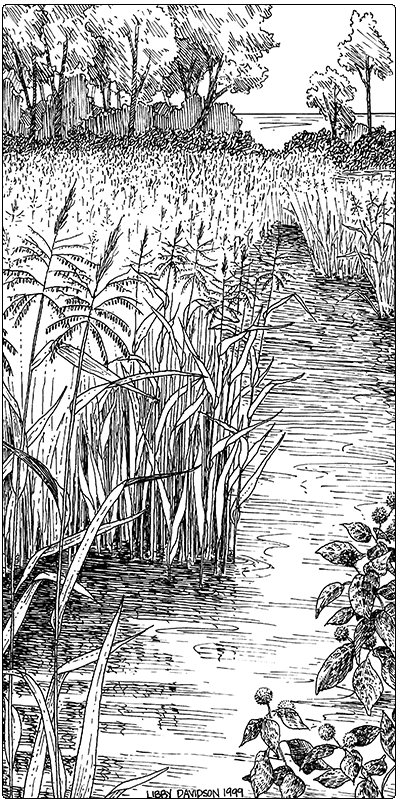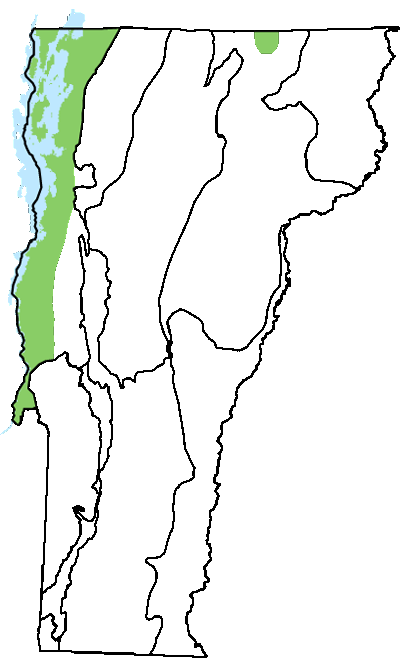Ecology and Physical Setting 
Wild Rice Marshes are found in wave-sheltered coves and on river deltas of Lake Champlain and Lake Memphremagog, and in the slow-moving backwaters of our larger rivers. These marshes are flooded for most of the year, with water depths usually less than two feet. The soils may become exposed when lake levels fall in late summer. The substrate is generally well-decomposed organic matter, although rich silty deposits may also be present. Wild Rice Marshes commonly occur as parts of wetland mosaics, along with Deep Broadleaf Marshes, Lakeside Buttonbush Swamps, and submersed or floating-leaved aquatic communities.
There are two species of wild rice in Vermont. Both are distinctive plants with interesting features. They are annuals that grow to 10 feet tall. Immature plants have narrow, underwater leaves that can be up to four feet long and resemble some submersed aquatic plants. Flowers are borne in a large panicle at the top of the plant, with male flowers on the lower spreading branches of the panicle and the female flowers at the top. The dark grain, or caryopsis, of wild rice matures in the early fall and is a food prized by both waterfowl and people.
Vegetation
Wild rice may form dense beds in some marshes, excluding many other species. In other marshes, it may mix with several deep marsh species, such as pickerelweed, broad-leaved arrowhead, and giant bur-reed. Like buttonbush, wild rice is able to withstand high spring waters and slowly dropping water levels over the early summer. These species are commonly found together. In the deepest Wild Rice Marshes, there may also be several species of floating-leaved and submersed aquatic species, including yellow waterlily, white waterlily, common coontail, and common bladderwort. The abundance of wild rice in any particular marsh may vary from year to year depending on water levels and the rate of seed germination.
Wildlife Habitat
The wildlife habitat provided by a particular Wild Rice Marsh is dependent on water level fluctuations and the proximity of other marshes and floodplain forests. The grains of wild rice are an especially important food for wildlife. Muskrats, which feed on wild rice, may be common in these marshes. Black ducks, mallards, and wood ducks are the most common waterfowl observed feeding in these marshes, but many other ducks may be present to take advantage of this food source. Some of the rare birds that use Wild Rice Marshes include black-crowned night heron, least bittern, American bittern, pied-billed grebe, and common gallinule. The very rare black tern may also nest on floating vegetation in Wild Rice Marshes.
 Spiny softshells may enter these deepwater marshes to feed on aquatic invertebrates. Common watersnakes may also be seen swimming through the dense vegetation or basking on a log.
Spiny softshells may enter these deepwater marshes to feed on aquatic invertebrates. Common watersnakes may also be seen swimming through the dense vegetation or basking on a log.
Related Communities
- Deep Broadleaf Marsh is dominated by pickerelweed, arrowheads, or bur-reeds. Deep Broadleaf Marshes and Wild Rice Marshes may intergrade.
- Deep Bulrush Marsh is dominated by bulrushes and may occur adjacent to and intergrade with Wild Rice Marsh. It is typically exposed to wave action and occurs on mineral substrate.
Conservation Status and Management Considerations
These deepwater marshes are closely tied to the water regimes of their lakes and rivers. Alteration of the natural hydrologic regime, by dam operation or the creation of impoundments, poses a threat to this community.
Wild rice has long been recognized as a very important waterfowl food. Being an annual and having readily collectable seeds, wild rice is relatively easy to introduce into appropriate wetland habitats. In Vermont, wild rice has been extensively planted in the past by the Fish and Wildlife Department as part of waterfowl management plans, so some of our Wild Rice Marshes may have been augmented by this practice. Wild rice is important to Native Americans for food and ceremonial use.
Distribution/Abundance 
Wild Rice Marshes occur around Lake Champlain and Lake Memphremagog. Similar communities occur throughout the eastern and midwestern United States and southern Canada.
Characteristic Plants
Shrubs
Occasional Species
Buttonbush – Cephalanthus occidentalis
Herbs
Abundant Species
Southern wild rice – Zizania aquatica
Northern wild rice – Zizania palustris
Occasional to Locally Abundant Species
Pickerelweed – Pontederia cordata
Broad-leaved arrowhead – Sagittaria latifolia
Giant bur-reed – Sparganium eurycarpum
Common cattail – Typha latifolia
Narrow-leaved cattail – Typha angustifolia
Yellow waterlily – Nuphar variegata
White waterlily – Nymphaea odorata
Common coontail – Ceratophyllum demersum
Common bladderwort – Utricularia macrorhiza
River bulrush – Bolboschoenus fluviatilis
Non-native Invasive Plants
Water chestnut – Trapa natans
Rare and Uncommon Plants
Arrow arum – Peltandra virginia
Associated Animals
Northern leopard frog – Lithobates pipiens
American bullfrog – Lithobates catesbeianus
Spring peeper – Pseudacris crucifer
Snapping turtle – Chelydra serpentina
Painted turtle – Chrysemys picta
Muskrat – Ondatra zibethicus
Mink – Neovison vison
Mallard – Anas platyrhynchos
Swamp sparrow – Melospiza georgiana
Wood duck – Aix sponsa
Hooded merganser – Lophodytes cucullatus
Common merganser – Mergus merganser
Great blue heron – Ardea herodias
Green heron – Butorides virescens
Lance-tipped darner – Aeshna constricta
Rare and Uncommon Animals
Spiny softshell – Apalone spinifera
Common watersnake – Nerodia sipedon
Black-crowned night-heron – Nycticorax nycticorax
Least bittern – Ixobrychus exilis
American bittern – Botaurus lentiginosus
Pied-billed grebe – Podilymbus podiceps
Common gallinule – Gallinula galeata
Black tern – Chlidonias niger
American black duck – Anas rubripes
Blue-winged teal – Anas discors
Green-winged teal – Anas crecca
Places to Visit
Missisquoi National Wildlife Refuge, Swanton and Highgate, U.S. Fish and Wildlife Service
South Bay Wildlife Management Area, Coventry and Derby, Vermont Fish and Wildlife Department (VFWD)
Sandbar Wildlife Management Area, Milton, VFWD
